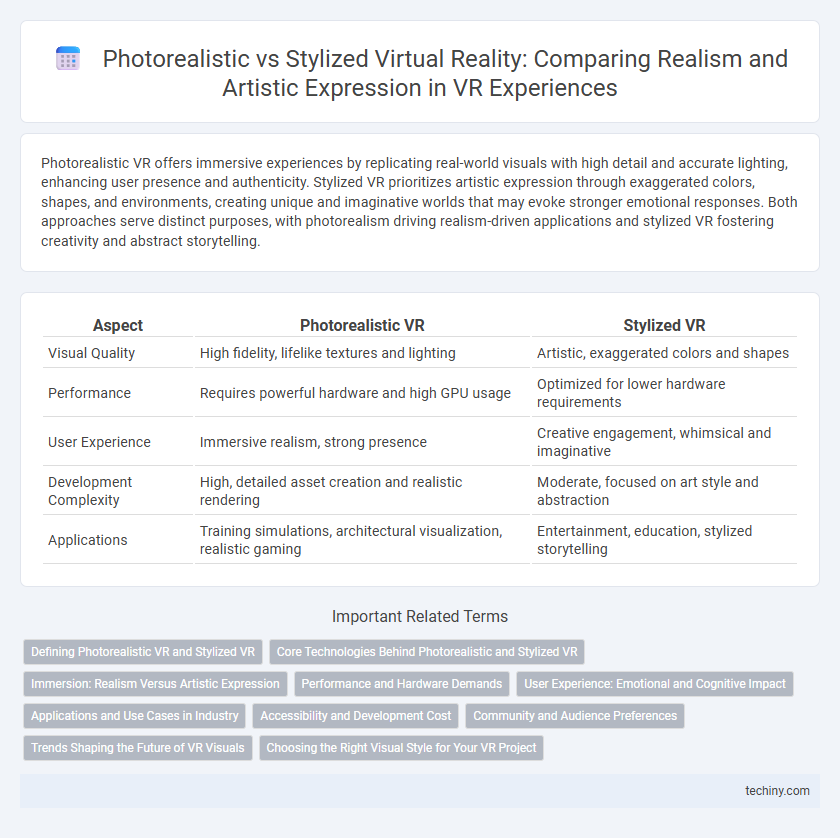Photorealistic VR offers immersive experiences by replicating real-world visuals with high detail and accurate lighting, enhancing user presence and authenticity. Stylized VR prioritizes artistic expression through exaggerated colors, shapes, and environments, creating unique and imaginative worlds that may evoke stronger emotional responses. Both approaches serve distinct purposes, with photorealism driving realism-driven applications and stylized VR fostering creativity and abstract storytelling.
Table of Comparison
| Aspect | Photorealistic VR | Stylized VR |
|---|---|---|
| Visual Quality | High fidelity, lifelike textures and lighting | Artistic, exaggerated colors and shapes |
| Performance | Requires powerful hardware and high GPU usage | Optimized for lower hardware requirements |
| User Experience | Immersive realism, strong presence | Creative engagement, whimsical and imaginative |
| Development Complexity | High, detailed asset creation and realistic rendering | Moderate, focused on art style and abstraction |
| Applications | Training simulations, architectural visualization, realistic gaming | Entertainment, education, stylized storytelling |
Defining Photorealistic VR and Stylized VR
Photorealistic VR replicates real-world environments with high-resolution textures, accurate lighting, and detailed 3D models to create immersive and lifelike experiences. Stylized VR employs artistic techniques such as exaggerated shapes, vibrant colors, and simplified forms to evoke specific moods or narratives, prioritizing aesthetic expression over realism. Both approaches enhance user engagement by catering to distinct visual preferences and storytelling objectives within virtual reality applications.
Core Technologies Behind Photorealistic and Stylized VR
Photorealistic VR relies heavily on advanced rendering techniques such as ray tracing, global illumination, and high-resolution texture mapping to create lifelike environments that mimic real-world lighting and materials. Stylized VR often employs cel-shading, procedural textures, and simplified geometry to achieve a distinct artistic aesthetic while optimizing performance. Core technologies behind photorealistic VR include real-time ray tracing GPUs and physics-based rendering engines, whereas stylized VR benefits from custom shaders and efficient polygonal modeling workflows.
Immersion: Realism Versus Artistic Expression
Photorealistic VR enhances immersion by replicating real-world visuals with high-fidelity textures, lighting, and spatial audio, creating an experience that closely mimics reality. Stylized VR, on the other hand, engages users through artistic expression and exaggerated visual elements, which can evoke stronger emotional responses and imaginative exploration. Both approaches influence immersion differently, with photorealism emphasizing realism and stylized VR prioritizing creative interpretation and unique atmosphere.
Performance and Hardware Demands
Photorealistic VR requires high-end GPUs and advanced rendering techniques such as ray tracing, resulting in increased hardware demands and potential performance bottlenecks. Stylized VR leverages simplified textures and geometry, enabling smoother frame rates on mid-range hardware while maintaining immersive experiences. Optimizing for stylized VR often results in lower latency and reduced power consumption, crucial for standalone VR headsets.
User Experience: Emotional and Cognitive Impact
Photorealistic VR enhances user immersion by replicating real-world environments with high visual fidelity, fostering strong emotional engagement and realistic cognitive processing. Stylized VR, with its artistic and abstract visuals, stimulates creativity and imagination, often reducing cognitive load and allowing users to focus on narrative or gameplay elements. Both approaches uniquely influence user experience by shaping emotional responses and cognitive engagement through their distinct visual styles.
Applications and Use Cases in Industry
Photorealistic VR offers immersive simulations crucial for industries like architecture, healthcare, and automotive design, enabling realistic training, virtual prototyping, and client presentations with high visual fidelity. Stylized VR excels in education, entertainment, and therapeutic settings by providing accessible, engaging experiences through artistic visuals that reduce cognitive load and enhance creativity. Both approaches optimize user engagement and task effectiveness by aligning visual style with specific industry requirements and objectives.
Accessibility and Development Cost
Photorealistic VR demands higher computational power and advanced hardware, which often limits accessibility for users with standard devices and increases development costs significantly due to the need for detailed assets and complex rendering techniques. Stylized VR offers a more cost-effective alternative by utilizing simplified graphics and art styles that reduce performance requirements, making it accessible to a broader audience and enabling faster development cycles. Choosing between photorealistic and stylized approaches depends on balancing the target audience's hardware capabilities with budget constraints and project goals.
Community and Audience Preferences
Photorealistic VR appeals to users seeking immersive experiences that closely mimic real-world environments, attracting communities interested in realism and training simulations. Stylized VR attracts creative audiences who prefer artistic expression and imaginative worlds, fostering vibrant, niche communities centered around unique aesthetics. User preferences largely depend on the purpose of VR applications, with photorealistic favored in education and professional sectors, while stylized VR dominates entertainment and social platforms.
Trends Shaping the Future of VR Visuals
Photorealistic VR leverages advanced ray tracing and high-resolution textures to create immersive environments that closely mimic reality, meeting growing demands for lifelike simulations in training and entertainment. Stylized VR emphasizes unique artistic expression through exaggerated colors, simplified shapes, and creative visual effects, appealing to experiences prioritizing imagination and accessibility. Current trends indicate a blending of these approaches, using AI-driven rendering techniques to optimize performance while maintaining visual fidelity, shaping a more diverse and flexible future for VR visuals.
Choosing the Right Visual Style for Your VR Project
Photorealistic VR offers immersive experiences with high-fidelity graphics that replicate real-world environments, ideal for training simulations, architectural visualizations, and medical applications. Stylized VR uses artistic designs and exaggerated visuals to create unique, memorable experiences suited for gaming, storytelling, and creative projects. Selecting the right visual style depends on project goals, target audience, hardware capabilities, and desired emotional impact.
Photorealistic VR vs Stylized VR Infographic

 techiny.com
techiny.com